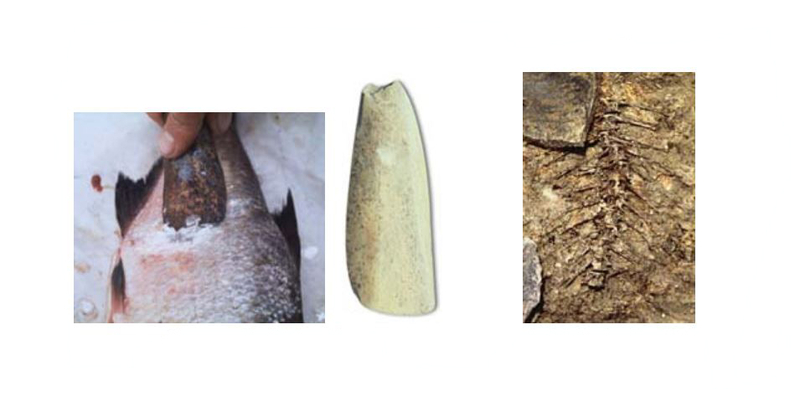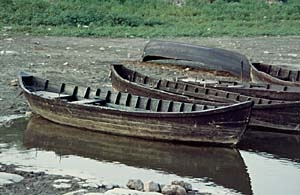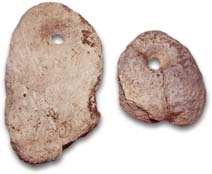- Home
- Hârsova, the chalcolithic village
- Sustenance
- Fishing
Fishing spearhead made of elk antler and reconstruction of spear with shaft ; probably used to hunt the bigger fish like sheatfish and sturgeon.
The food resources drawn from the great river were, undeniably, the subject of a very particular exploitation: Fishing and shell collection were annually a rhythmic part of the life of the men and women of the Hârsova tell. This was to have consequences, besides, on the allocation of a function or position within the community.
The fishing paraphernalia, which has been preserved, such as fishing spearheads made of antler, sinkers made of bone and boat anchors, and an extraordinary assortment of fish scales and bone, suggest an intensely active fishing community. The catch was very diversified : there is evidence of carp, bream, roach, angelfish, rudd, pike, sandre, pole flounder, sheatfish(silure) and sturgeon.
Nevertheless, this first impression of abundance must be tempered. What, indeed, could be the economic importance of fishing if one compares the weight of food available from a pig of a hundred kilos to a fish of a few hundred grams ?
Bone chisel : based on the wear of the blade, and some experimenting,it is thought to be used for scaling fish.
We cannot, in the end, know exactly the technique of fishing. The diversity of the species, the variety of habitats, sizes, and eating habits, all evoke a variety of possible fishing techniques. But beside the spears which survived, what were the other tools used ? Today, as well, most of the fishing tools used by the fishermen of the Danube (nets and lines) are made of perishable materials and are unlikely to found by the archaeologists of the future.
The shells of freshwater molluscs, predominately river muscles, are numbered in the tens of thousands at the Gumelnita level of the tell. The study of dimensions of the muscle shells of the river show to the intentional selection of a certain sizes to be consumed. This suggests gathering by hand along the banks of the river when the water was low.
The fragments of fresh water turtle shells showing traces of cuts or of having been burnt, and the discovery of crayfish gastroliths attest to the consumption of these animals and underlines the fact that few of the river's animals where not eaten.
Indirect evidence of the boats of the fishermen of the Gumelnita culture by the discovery of a limestone weight, possibly an anchor. However we know nothing of the types of boats used : were they simple dugout monoxyles (dug out of a trunk) or more elaborate boats ?
Limestone weights, probably used by fisherman for anchoring their boats.



